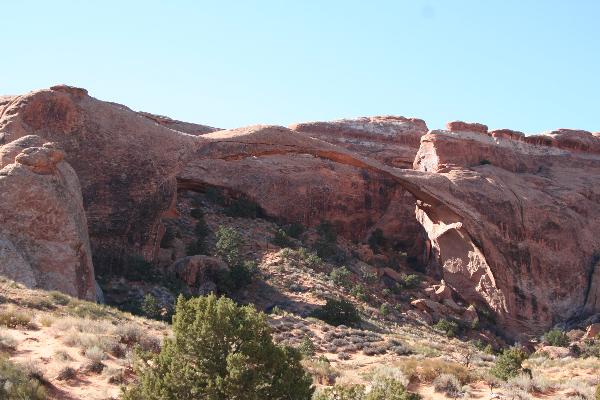Landscape Arch in Arches National Park

Two major formations are visible in the park today. They are the salmon-colored Entrada Sandstone and the buff-colored Navajo Sandstone.
Over time water seeped into the cracks, joints and folds of these layers. This can be noticed by the stains on the surface located on the walls. Ice formed in the fissures, expanded the cracks, put pressure on surrounding rock and eventually broke off bits and pieces. Winds later cleaned out the loose particles. A series of free-standing fins, thin ribbons of rock remained. Wind and water attacked these fins until some of the rock material gave way and chunks tumbled out. Many damaged fins collapsed. Others, with the right degree of hardness and balance, survived despite their missing sections. These became the famous arches.
Landscape Arch is the second most famous arch in Arches National Park (after Delicate Arch which is found on the Utah License Plate). This arch spans a width of 290.1 feet and is classified as the longest arch in the world. From [your present location] there was a trail that leads under the arch, but was closed in 1991 when a 61' slab weighing 180 tons split from the right side. Several people were actually fortunate enough to witness this break. Pictures can be seen of the rock splitting from the arch at the site.
Landscape is arch is known as a Arc National Arch. This type of natural arch is due to erosion after its initial formation. The erosion processes that govern subsequent development are weathering and compression strengthening. Arc Natural Arch is presumed to be very old and near the end of its lifecycle. Although quite rare, there are enough examples to warrant a taxonomy type. These structures are very strong and due to the lintel being shaped like a full or partial catenary, the direct results of compression strengthening. Massive abutments are typical because they allow the natural arch to distribute a greater weight when it is first formed.
While in the Park, please watch where you step and be aware of the Cryptobiotic Crust. It’s alive, so watch your step! Once called cryptogamic soil, this dark crust covers much of the untrampled desert. Composed of cyanobacteria as well as lichen, algae and fungi, this covering protects against erosion, absorbs moisture provided nitrogen and other nutrients for plant growth. Avoid crushing these life-giving organisms. Stay on trails. Without these crusts, many of the larger plants could not survive, and if the plants go, so do the animals. The desert could lose much of the life that makes it such a magical place.
To get credit for this cache you need to complete the following:
1. What is the name of the Sandstone that makes up this arch?
2. Find the thinnest section of the arch and give your best estimate of the thickness. [DO NOT CLIMB ONTO THE ARCH!!!]
3. What differences do you see between the base of the right and left side of the arch? Stains, Cracks, Other?
4. Why is this Arch considered to be at the end of its lifecycle?
5. Take a picture of you and your GPS with the arch in the background. (All pictures are optional)
Email me at landonsmith@familyofours.net with the answers for 1-4 and attach your picture(s) to the log.